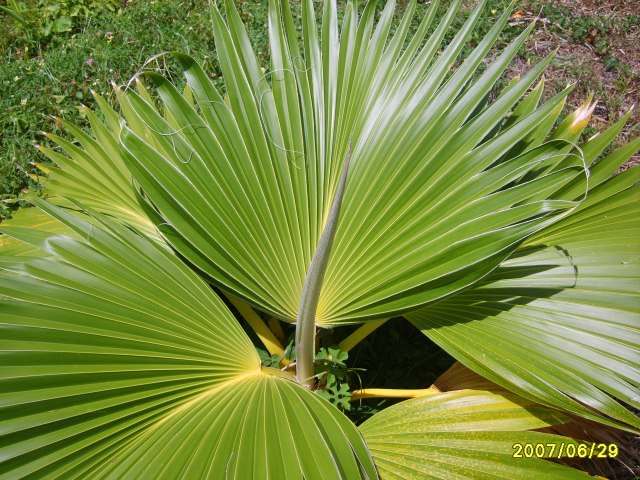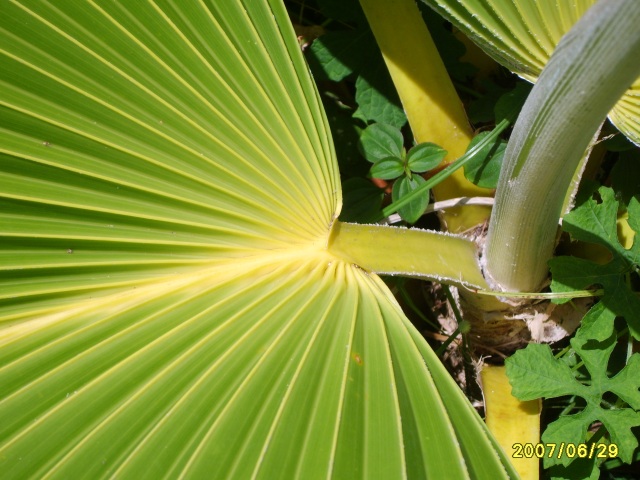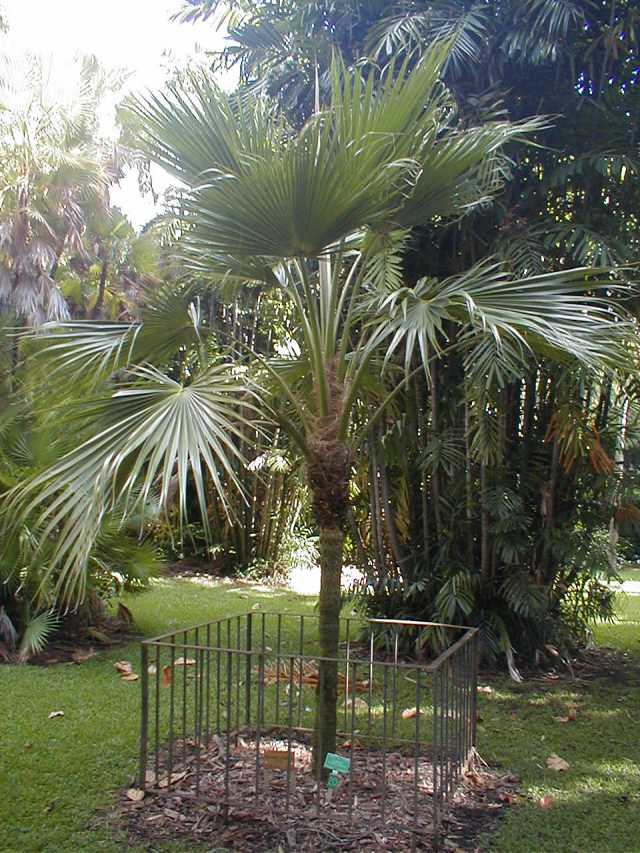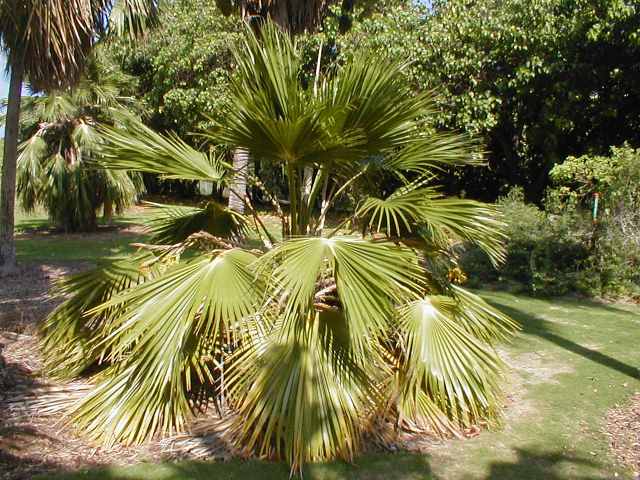There are five species of loulu endemic to the Island of Maui: Pritchardia arecina, P. forbesiana, P. glabrata, P. munroi, and P. woodii. Three of the species are also endemic to other islands. Pritchardia munroi and P. forbesiana are also endemic to the Island of Molokai, as is P. glabrata to the Island of Lanai.

Pritchardia arecina, Nahiku, Hana, Maui
Pritchardia arecina is endemic to the slopes of Haleakala on the eastern end of the Island of Maui where it grows in the rain forest at an elevation of 2000 to 4000 feet. The epithet is Latin for “little Areca”.
The trunk reaches heights of 40 feet or more with a diameter of 1 foot or less. The leaf crown is hemispherical, with large, stiff, wedge shaped, 3 foot long leaves on 4 foot long petioles. The young leaves are yellowish and the mature leaves retain a layer of golden, fringed scales on the under surfaces. P. arecina has large round to ovoid fruit 2 inches across are dark brown to black and shiny when ripe.
As with other flora, Hawaii‘s geographic isolation has had a dramatic impact on the evolution of the genus Pritchardia. “Pritchardia is a phenomenon of Pacific insular distribution with 2 species in Tonga and the Fijian Islands, P. pacifica and P. thurstonii, 2 species in the Tuamotu Islands of French Polynesia, P. pericularium and P. vuylstekeana, and 1 species of unknown Polynesian origin, P. maideniana, yet nowhere has the genus proliferated as in the Hawaiian Islands. To date, the names of 33 species and 6 varieties of Pritchardia have been validly published for Hawaii, making Hawaii the richest palm area in terms of species in the United States.” (Hodel, 1980)
In respect to the proliferation into many taxa or the adaptive radiation of the genus Pritchardia, and given that the specimen in Nahiku, shown in the photograph above, closely follows the description of the species, variations in the physical character of different specimen of the species arecina are apparent in the following cases:

Pritchardia arecina, Piilanihale Heiau, Kahanu Garden, Honomaele, Hana, Maui
This mature specimen stands at the foot of Piilanihale Heiau in Honomaele at the Kahanu Garden. The segments are somewhat longer and slightly pendent. The seeds are significantly smaller that the 2 inches attributed to the species; the seeds from this tree are approximately 3/4 inch in diameter.

Young Pritchardia arecina, Kahanu Garden, Honomaele, Hana, Maui

Young Pritchardia arecina, Kahanu Garden, Honomaele, Hana, Maui

Young Pritchardia arecina, Kahanu Garden, Honomaele, Hana, Maui
At Kahanu Garden, many young trees have been planted on the grounds in recent years. Even though the seeds originated from the same source, the seedlings are beginning to show some character differences as they mature. In the juvenite plants above differences in coloration, as well as leaf and petiole details are apparent.

Pritchardia arecina, Private Garden, Muolea, Hana, Maui
The specimen pictured above shows significantly pendent segments. The seeds on this tree have been different sizes over the years. In 1990, when I first saw this tree, the seeds were only 3/4 inch in diameter, however, in 2006, the seeds were approximately 1 1/2 inches in diameter, twice the previous size.

Young Pritchardia arecina, Wakiu, Hana, Maui
This young specimen above growing in my garden at Wakiu shows little or no tomentum on the underleaf, it has long slightly pendent segments, and long narrow petioles. The seed for this young tree came from the tree in Nahiku. It resembles the specimen that grows in the Hawaiian garden at the former Maui Zoo (now the Maui Nui Botanical Garden). The seeds on that mature specimen were 3/4 inch in diameter. The caretaker Rene Silva said that that tree was from a seed gathered by a state forest ranger from the Kailua area of East Maui.

Mature Pritchardia arecina, Wakiu, Hana, Maui
This mature specimen growing in my Wakiu garden is another descendant of the first tree pictured in this Maui chapter. The seeds produced by this tree range from 1/2 to 3/4 inch in diameter. The undersides of the leaves show the distinct gold tomentum around the hastula area on older leaves and a more silvery-white tomentum on the younger leaves. This specimen is approximately 10 years old.
The parent tree grows at an elevation of approximately 1000 feet. The ovoid seeds off the parent tree are 2 inches in diameter and are dark brown to black and shiny when ripe. Seeds collected from a stand of Pritchardia arecina growing in a native habitat in the rain forest of Kuhiwa at an elevation of approximately 3000 feet are identical to the ones off the tree in Nahiku. The lone tree in Nahiku was planted as part of an arboretum by Marion Cabral more than 50 years ago. Due to rats, pigs and worms in the area devouring the fallen seeds, no volunteers have ever established themselves under or near the parent tree.

Tomentum on underleaf is golden on older leaves (Pritchardia arecina)

Tomentum on underleaf is silvery-white on younger leaves of the same tree.

Pritchardia arecina, Kahanu Garden (near awa garden), Honomaele, Hana, Maui
This mature specimen of Pritchardia arecina growing in Kahanu Garden exhibits segments that are long and slightly pendent; it produces medium size seeds approximately 3/4 inch in diameter. This tree is quite similar to the specimen growing at the foot of Piilanihale Heiau.

Pritchardia arecina seeds from Nahiku tree
The seeds pictured above came from the Pritchardia arecina specimen growing in Nahiku. They are identical in shape and size to the seeds that come from trees in the native habitat 2000 feet higher up the slope of Haleakala in the rain forest of Kuhiwa.

Pritchardia arecina (Wakiu) seeds
The second photo is of Pritchardia arecina seeds from the mature tree that grows in my Wakiu garden. I believe the size difference is directly related to the elevation difference. Although the Nahiku tree is approximately 2000 feet lower in elevation than the Kuhiwa habitat, the climate is similar. Wakiu is about 120 feet in elevation, but it is also a drier climate and does not have as low temperatures in the winter as Nahiku and Kuhiwa.

Pritchardia forbesiana, Keanae Arboretum, Keanae, Maui
Pritchardia forbesiana is endemic to West Maui and East Molokai. This species was reported by Beccari and Rock (1921) growing near Mauna E’eke north of Pu’u Kukui (West Maui Mountains) at about 4000 feet elevation. In 1976, Pritchardia forbesiana was collected near the beginning of the trail to the summit of Pu’u Kukui at 3000 feet elevation (Hodel, “Notes on Pritchardia in Hawaii“, 1980; “A Review of the Genus Pritchardia“, 2007).
Through visual examination of the specimen growing at the Keanae Arboretum, I am able to describe Pritchardia forbesiana as growing to a height of 60 feet or more with a trunk diameter of approximately 10 to 12 inches. The leaves are a waxy dark green on both sides; the segments run approximately 1/3 the way to the hastula of the leaf and are stiff to apices. The leaves appear to be approximately 3 to 4 feet in diameter with stout petioles approximately 4 feet long. The inflorescences are shorter than the leaves and produce globose fruit approximately 1 to 1 1/2 inches in diameter that are purple to black when ripe.

Juvenile Pritchardia forbesiana, Wakiu, Hana, Maui
This young tree is growing in a clay soil that is solid when dry and mush when soaked over a period of several days of constant rain. It has a definite yellow-golden hue in the petioles and the ribs of the leaves both the upper and lower surfaces.
The Hawaiians called the yellow hued Pritchardia, Loulu lelo literally meaning yellow loulu. Though the name is tied more specifically to Pritchardia hillebrandii, Loulu lelo would be an appropriate name for P. forbesiana and P. arecina as well; possibly others too.

Pritchardia forbesiana (crown detail) Keanae Arboretum, Keanae, Maui
The fruit clusters are seen in the crown of this tree at the arboretum in Keanae. The crown is rather loose and airy, possibly due to its location which is shady most of the day.

P. forbesiana fruit
The fruit of Pritchardia forbesiana are approximately half the size of Pritchardia arecina. The coloration when ripe is about the same, but P. arecina is tannish gray before it turns black.

Pritchardia glabrata, Kahanu Garden, Honomaele, Hana, Maui
Pritchardia glabrata is endemic to the Island of Maui, it grows at elevations of 1500 to 2000 feet in the valleys of the West Maui Mountains near the Iao Needle and on the Island of Lanai. It is little known and not widely cultivated. The epithet is Latin for “glabrous”.
An Encyclopedia of Cultivated Palms by Robert Lee Riffle and Paul Craft, published by Timber Press in 2003 classifies this species as Pritchardia remota var. glabrata. The specimen at Kahanu Garden produces seeds of approximately 1/2 inch in diameter as does the specimen growing in a private garden in Muolea.

Pritchardia glabrata with fruit, Kahanu Garden, Honomaele, Hana, Maui

Pritchardia glabrata, Private Garden, Muolea, Hana, Maui
This specimen growing in a private garden in Muolea is more than 30 years old; the trunk is approximately 3 feet in height and has a diameter of 6 inches.

Pritchardia munroi, Maui Nui Botanical Garden (formerly Maui Zoo), Kahului, Maui
Pritchardia munroi is a rare and critically endangered species endemic to the islands of Maui and Molokai. Their native habitats are a dry, evergreen scrub forest in two gulches at an elevation of 2500 feet above Kamalo near Puakoolau on Molokai and south of Pu’u Kukui on Maui. The epithet honors George Munro, an early 20th Century New Zealand naturalist on Molokai.
The trunk of this species grows to 20 feet in height and 1 foot in diameter. It is light brown and covered with dense, brown leaf sheath fibers in its younger parts. The leaf crown is nearly spherical and is open because of the 4 foot long stout petioles. Individual leaves are deep green, 3 feet long, semicircular to wedge shaped, and deeply costapalmate. The segments are shallow and are stiff in younger leaves, with slightly pendent apices in older leaves.

Pritchardia munroi, Wakiu, Hana, Maui

Pritchardia munroi (hastula detail), Wakiu, Hana, Maui

Pritchardia munroi (underleaf), Wakiu, Hana,Maui
The two Pritchardia munroi trees shown in photographs above, one located in Maui Nui Botanical Garden and one in my Wakiu garden, are closely related. The tree growing in Wakiu is an offspring of the tree growing in Kahului. The seed for the Wakiu tree was collected in the mid 1980s when Maui Nui Botanical Garden had not yet existed, the tree was part of the Hawaiian Garden in the old Maui Zoo.
These trees show a dramatic example of environmental impact on the growth pattern of loulu. These photographs were both taken in the year 2006. The Kahului environment is one of fairly low rainfall, sandy soil and mostly sunny days. In Hana, the rainfall is considerably greater, the soil is clay with more humus on the surface layer and sunshine is less intense throughout the year.
The age of the parent tree is unknown; it appears not to have gained significantly in height since the seed was collected. The tree in Hana was a seedling yet in 1990 when it was planted in its present location in Wakiu. The size difference between parent and offspring is remarkable. Both trees produce medium size fruit, approximately 3/4 inch in diameter. I have not come across any written account of fruit size for Pritchardia munroi in its native habitat.

Pritchardia munroi (fruit), Wakiu, Hana, Maui
Finally, we add what was formerly thought to be stands of Pritchardia arecina growing in Waihoi and Kipahulu Valleys, Pritchardia woodii is now considered a new species. These newly named palms grow in groups of 5 to 10 trees scattered in their habitat areas in East Maui.
Pritchardia woodii are endemic to the valleys of Waihoi and Kipahulu on the eastern end of the Island of Maui. They grow at an elevation of 2000 to 3000 feet. This species has stems (trunks) with a diameter of 8 to 10 inches, are grayish, longitudinally grooved, and grow to a height of 40 feet or more. The crown consists of some 15 to 20 leaves that are nearly circular with a diameter of 3 1/2 to 4 feet held on petioles 2 to 3 feet long. The fruit are large; ovoid to spherical with diameters of 1 1/2 to 2 inches.
These trees are considered endangered due to the low numbers growing in habitat. They are known to be cultivated at the Wahiawa and Ho’omaluhia Botanical Gardens on Oahu. Pritchardia woodii is said to be very similar to Pritchardia lanigera growing on the Big Island, however, it lacks the woolly indumentum on the rachillae and rachis found on that species. P. woodii is similar to P. arecina which grows to the north and northeast on the slopes of Haleakala in slightly wetter areas. But P. arecina has leaf blades which are completely covered abaxially with lepidia and the petioles are covered with fibers at their base.
The epithet honors Ken Wood, a field botanist for the National Tropical Botanical Garden on Kauai. He is an avid collector of loulu, the Hawaiian Pritchardia.
























































